The richness and diversity of Florida’s waters are known all over the world. So much so, that passionate anglers come from every corner of the planet for the chance to hook into the fish of their dreams. Whether you’re after a Bull Redfish, a feisty Mahi Mahi, or magnificent Billfish, the Sunshine State is the playground of them all. The sheer number of Florida game fish is going to have you reaching for your rod.
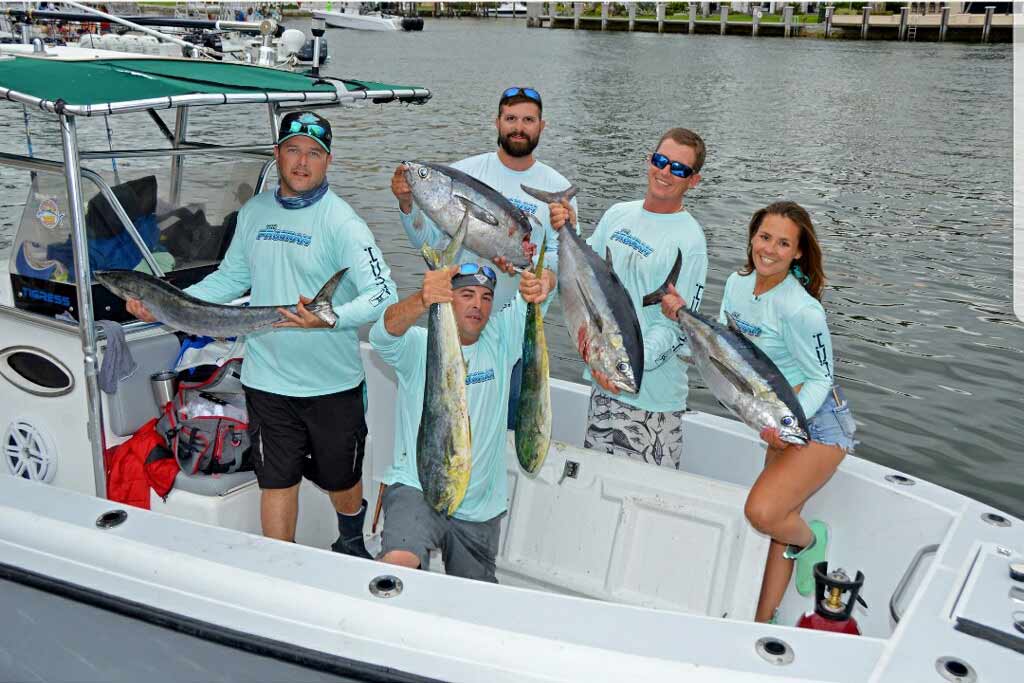
When you’ve got dozens of options, it’s very hard to decide where to start. Worry not! We’ll talk about the hardiest and most loved fish species you can find in Florida to get you off on the right foot. This article covers when, where, and how you can target your selected species. Whichever one you choose, you can’t go wrong. And if you get them all, well… more power to you!
Table of Contents
Redfish
Of all the inshore species in Florida, the mighty Redfish is a catch you can’t miss. These beautiful bright red to bronze fish are among the most famous and widespread species in the state. They hunt in shallow waters and fight with no mercy. Reds can live both in saltwater and brackish waters. On average, they weigh between 10–20 pounds. If you get a bigger specimen than that, you’ve got a Bull Redfish on your hands. If that’s not enough, they’re delicious and can easily be turned into a delicious dinner.
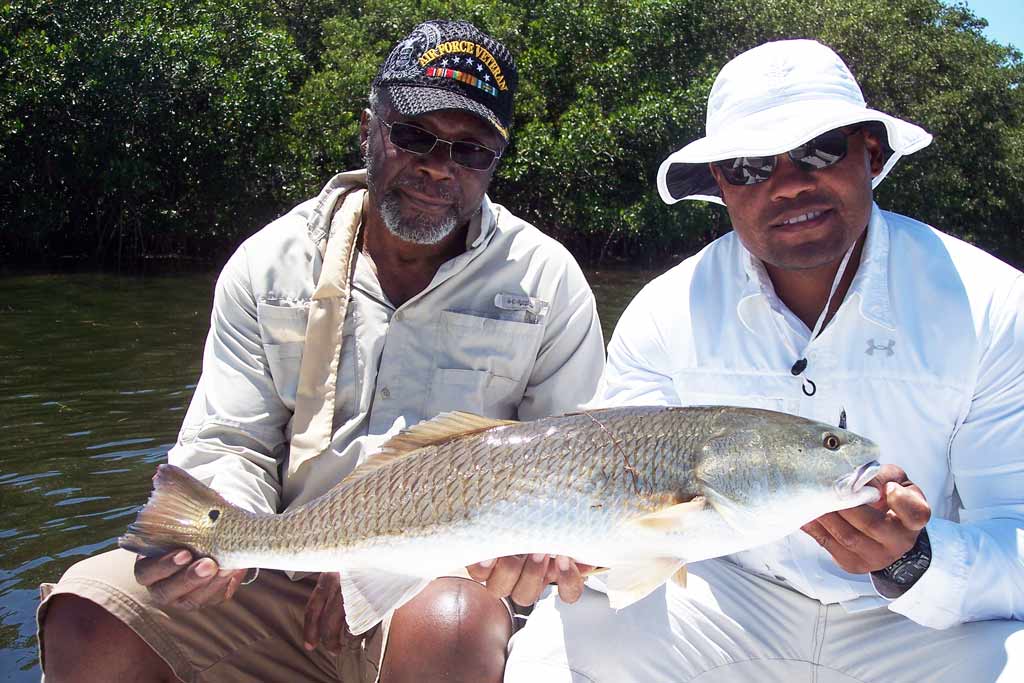
When?
You can go after Redfish year-round, and you won’t be disappointed. The best time to catch them is in the heat of the summer when chances of landing a Bull are highest. Fall can be just as good, and winter will put you on smaller fish, but their numbers are still impressive.
Where?
Find skinny waters (up to four feet), and you’ll find Reds. Flats, beaches, piers, oyster bars, and mangroves are their playground. Basically, wherever there’s structure, there are Redfish. The best spots in Florida to target them are the Indian River Lagoon, Tampa Bay, Mosquito Lagoon, Sarasota Bay, and Clearwater, to name a few.
How?
Redfish aren’t particularly picky about their food, so they respond well to lures and live bait. They’re big fans of crustaceans, so crab and shrimp are the way to go. If you prefer artificials, you can’t go wrong with popping corks, weedless spoons, and rattling plugs. Pair soft plastics with a strong scent and the bite will be rewarding. For more info and all-things-Redfish, check out this article.
Snook
Snook is deservedly considered one of the most iconic Florida game fish. They can live in saltwater, brackish, and even freshwater environments, and weigh between 5–50 pounds. Snook are fussy about their food and won’t be fooled easily. They’ve got a big mouth they’re not afraid to use. As ambush predators, they attack their prey with wild abandon. Once a Snook takes the bait, its aggressiveness is formidable. The hard work will pay off because grilled Snook fillets are super tasty.
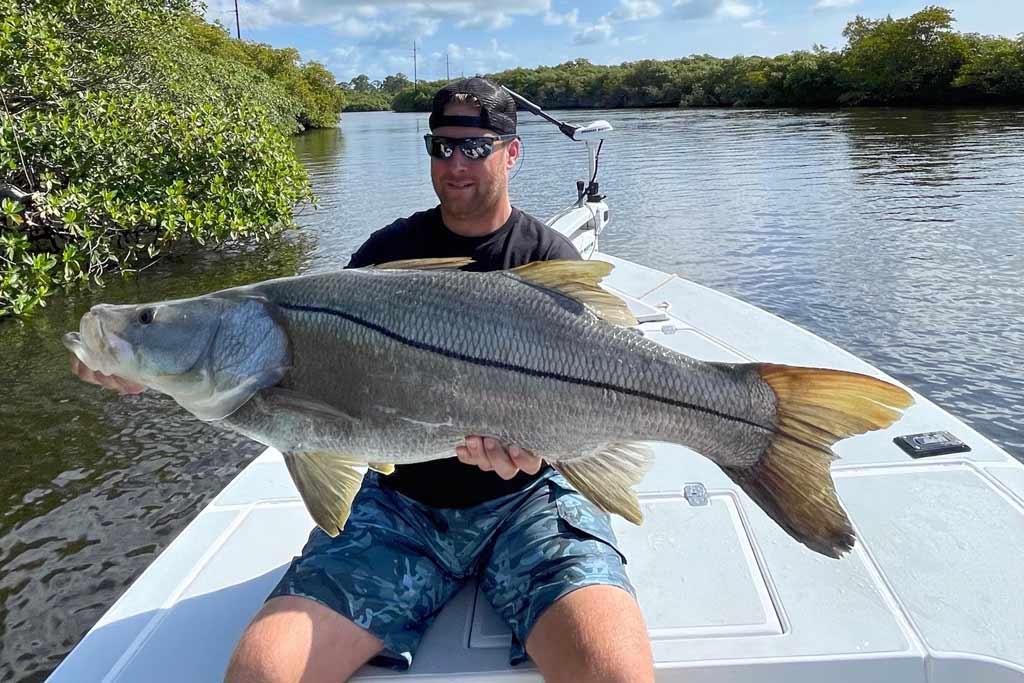
When?
Snook are a tropical species, so they’re at their most active in spring and summer. They spend the summer in flats and shallow bays, feeding and spawning. As cold fronts come in (as much as that’s possible in Florida), Snook withdraw to creeks, rivers, and backwaters, where the temperature is more comfortable. This is where you’ll find them in winter.
Where?
Snook live in warm waters (60ºF and up), so they thrive in Southern Florida. You can target them in Fort Pierce and Miami on the Atlantic Coast. On the Gulf side, Snook Alley in Sarasota, the Everglades, Captiva, Fort DeSoto, and Boca Grande are some of the locales that boast a strong Snook bite. Just remember to stay quiet when targeting them, otherwise, they’re as good as gone.
How?
Hooking into a Snook on light tackle is a memorable experience. Some fishermen swear by artificial lures when going on a Snook hunt, and you can’t go wrong with spinnerbaits, soft plastics, and diving plugs. Snook won’t refuse live bait either, especially if it’s in the form of shrimp, pinfish, or sardines.
Tarpon
In Florida, when you hear “Bow to the King,” every angler knows you’re talking about Tarpon fishing. Tarpon is one of the most sought-after species here, thanks to their impressive size (100–200 pounds) and ferocious fighting abilities. Tarpon’s hard mouth makes it difficult to set the hook, and if you do, get ready for headshakes and acrobatic jumps. The fish is notorious for getting away, which makes them the ultimate inshore challenge.
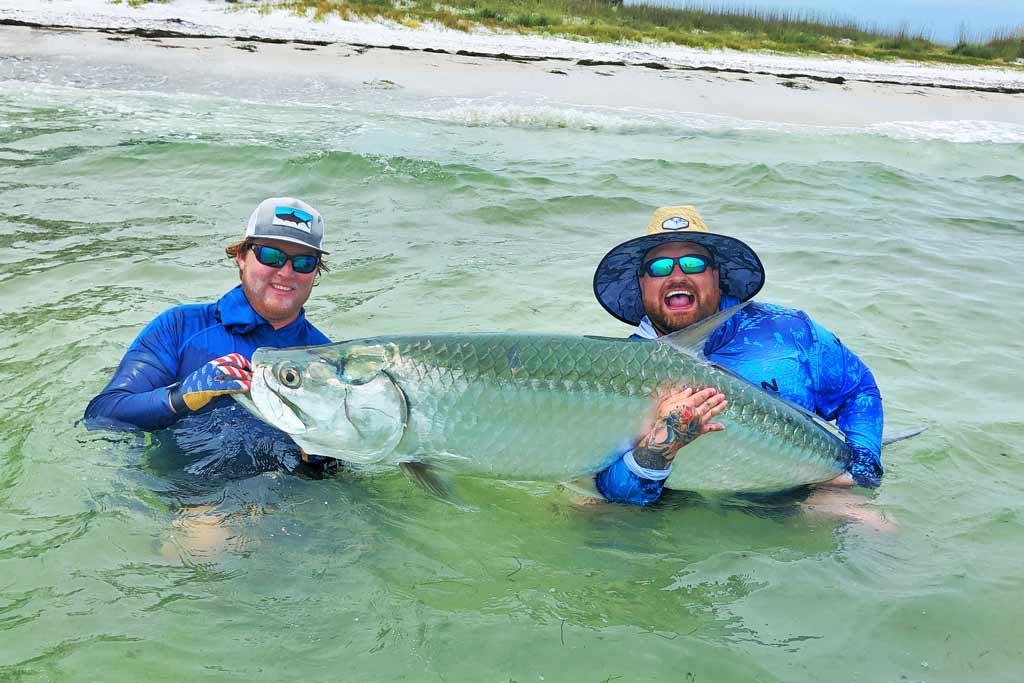
When?
Tarpon is at your disposal every day of the year, as long as you know where to find them. They’ve got a particular migration pattern that local captains know everything about. During the winter, they stick to the Florida Keys. As spring and summer come along, they spread out north, and you can target them on both Florida coasts.
Where?
In the coldest parts of the year, Tarpon stick to backwaters, inlets, and around bridges. Come spring, they move to the flats, where the water is gin-clear and sight fishing opportunities are marvelous. When it comes to top Tarpon fishing destinations, Boca Grande is the all-time favorite, with Miami, Islamorada, Tampa Bay, and Homosassa following close behind.
How?
The first thing to know about Tarpon is that they’re a strictly catch-and-release species. There are many ways to go after them, but sight fishing and fly fishing are favorites. Spinning tackle will do the trick – the bigger the fish you want, the hardier tackle you’ll need. Crabs, shrimp, and pilchards are great live bait options. Artificials like topwater lures, silver spoons, and spinners are productive in the flats.
Spotted Seatrout
If you’re looking for a fish that’s abundant, not too hard to catch, and delicious, Spotted Seatrout is the way to go. Also known as Speckled Trout (Specks), your average catch can weigh about five pounds. Anything more than that, and you’ve got a Gator Trout. This is the species to chase if you’re on the water with beginners or kids. They’re one of the best-tasting inshore inhabitants and undoubtedly a favorite Florida game fish.

When?
There’s a good chance to land a Trout year-round in Florida, though summer and fall provide the optimal fishing conditions. This is when the water is at its warmest (the upper sixties) and when Spotted Seatrout are most aggressive.
Where?
Specks are usually not too hard to find – they stick to grassy flats and inshore waters up to 10 feet deep. They also hunt for food around structure, jetties, and oyster bars. They follow the sun to keep warm and baitfish to keep full. Top Trout fishing spots include the Everglades, Sarasota, Tampa Bay, Mosquito Lagoon, and Englewood.
How?
Florida Trout love to eat, which makes the lives of anglers a lot easier. They’ll double down on anything that appears injured and loud. That’s why popping corks are probably the best lure you can choose. Hard plastics and topwater lures will work just as well. Specks won’t turn down live bait either, especially if you use threadfin herring and live shrimp.
Cobia
A fish that deserves a spotlight in the nearshore realm is Cobia. Relentless fighters and widely available, Cobia will test your angling skills every time to get them on the line. They’re just what you want when you’re in the mood for an adrenaline rush followed by a delectable dinner. Your average Cobia weighs anywhere from 20–30 pounds. You can also find them offshore, where they’re bigger and feistier.
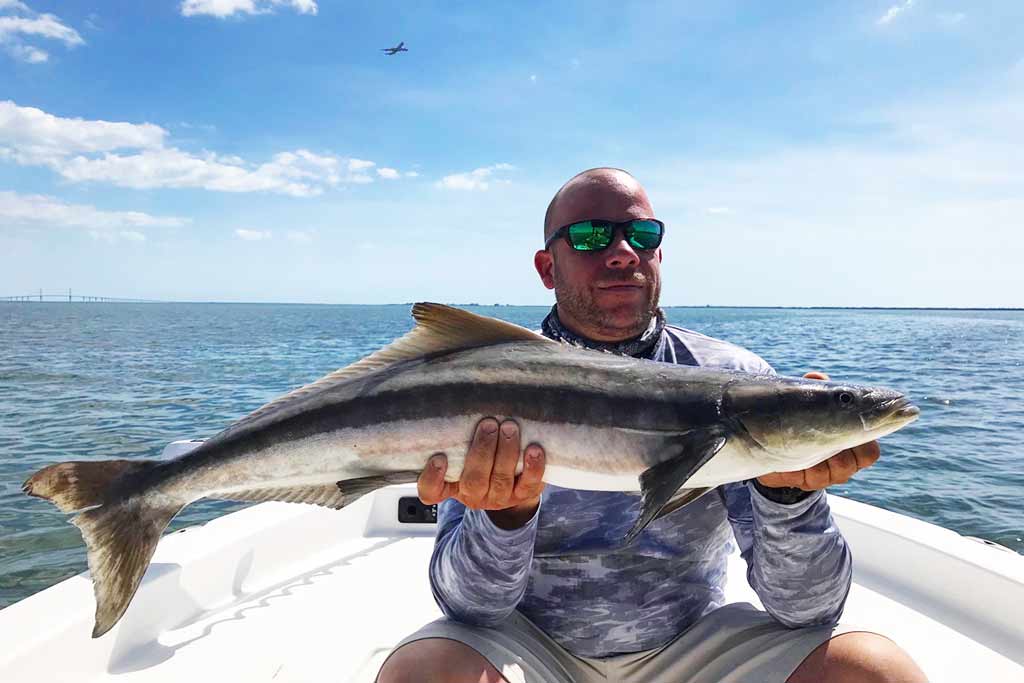
When?
The best time to go after Cobia in Florida is in winter and spring. If you’re fishing in the Gulf, summer is peak Cobia time, where both the quantity and quality of the fish are excellent. Southern Florida is the home of this species and that’s where you can go after them any day of the year.
Where?
The key to finding Cobia is finding the structure where they hunt. Reefs, wrecks, buoys, grass beds, and floating debris are all potential feeding grounds. The best place to fish for Cobia is in the Florida Keys, as well as Fort Walton Beach, Tampa, Jacksonville, and Stuart.
How?
There’s a variety of techniques you can use to land a Cobia. Traditional casting and spinning work like a charm. They’re lazier than most fish, so you’ll need to get the offering right in front of them to get them to bite. These gluttonous fellas will take lures and live bait. Blue crab are their favorite, closely followed by pinfish, eels, and shrimp. On the lure side of things, diving plugs, poppers, and soft plastics are go-to options. For a one-of-a-kind adventure, try fly fishing for Cobia.
King Mackerel
We can’t talk about nearshore Florida game fish without giving a shoutout to King Mackerel. Also known as Kingfish, this species is a common catch on fishing boats all over the state. They usually weigh around 20–30 pounds and move around in schools, religiously following bait fish. Bigger specimens (“smokers”) are loners and prefer offshore waters as their hunting grounds. King Mackerel fight well and they’re the bread-and-butter of the fishery in many parts of the Sunshine State.
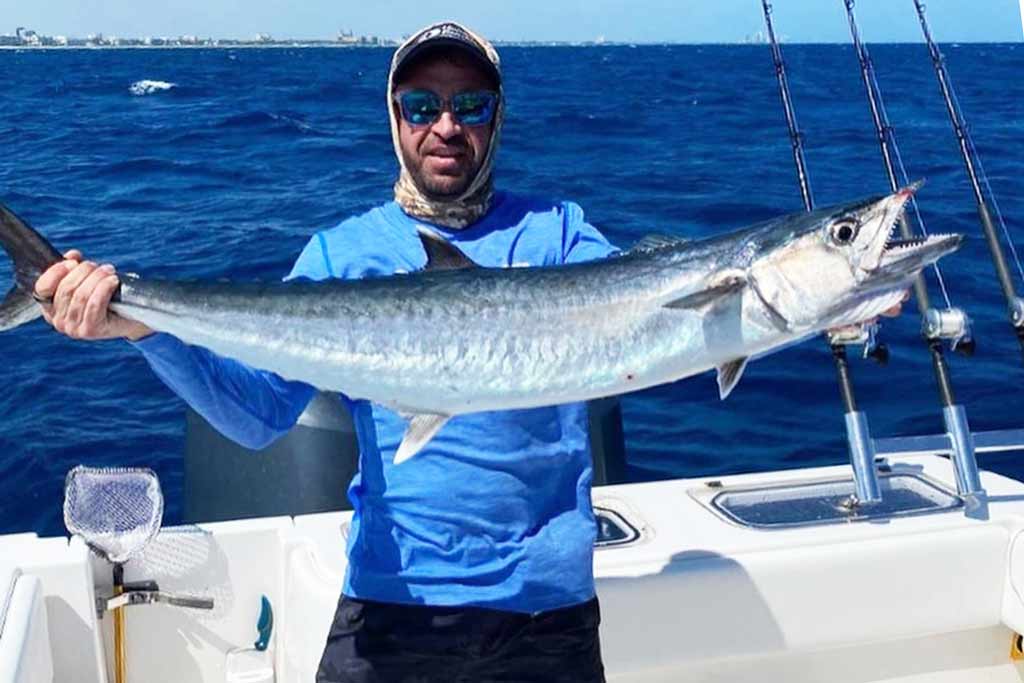
When?
Southern Florida is where you’ll find Kingfish year-round. Every spring, they start the journey north to their spawning grounds, which marks the best fishing along the Gulf Coast in summer and fall.
Where?
King Mackerel are insatiable predators, so they’re never far away from their food, aka bait fish. Reefs and wrecks are the best places to look for them, as well as piers, inlets, and rock ledges. Destin, Panama City Beach, St. Petersburg, Key Biscayne, and Pensacola are just some of the most productive King Mackerel fishing spots.
How?
If you want a Kingfish, you’ll need a boat. They stick to nearshore and offshore waters, so the only way to access them is from a boat. These pelagics respond best to trolling and you can use planer boards to get your offering to them. Live bait in the form of their favorite bait fish – minnows, herring, sardines – is irresistible. Spoons and plugs are the most efficient artificial lures. Remember to have a strong leader, because King Mackerel have a lot of teeth and they’re not afraid to use them to break free.
Mahi Mahi (Dolphin)
As we sail into the offshore waters, it’s time to talk about Mahi Mahi – a very strong fish, as its Hawaiian name suggests. We dare say that Mahis are among the most loved Florida game fish, thanks to their speed, forceful acrobatics, and flavorful meat. Their beautiful coloring makes them stand out, and they average 20–30 pounds. Mahi Mahi bigger than that are called Bull Mahi. They’re a great target for beginners and experienced fishermen alike.

When?
Mahi Mahi are known for moving around a lot. The most productive time to target them is in spring and early summer, but you can find them around the Keys well into the fall.
Where?
Mahi Mahi love deep waters, at least 100 feet deep. That’s why you’ll need to travel 20 miles offshore to get to them. They’re a pelagic species, and they feed close to the surface around anything that’s floating. The Atlantic Coast boasts stronger numbers of Mahi Mahi than the Gulf. But Port Canaveral, Panama City Beach, Destin, and Pompano Beach are all go-to spots for your dose of Mahi Mahi fishing.
How?
There’s no better way to bag a Mahi than by trolling. These fish eat first, and ask questions later. Throw some chum overboard and you might start a feeding frenzy that results in multiple hookups. Beware that you’ll need sturdy tackle to overpower their headshakes and aerial displays! Bait in the form of live or dead pilchards, ballyhoo, cigar minnows, and squid is the recipe for success. The best option for artificials are spoons, soft plastics, and diving plugs.
Wahoo
With such a wide variety of game fish to catch in Florida, Wahoo often isn’t the first species that comes to mind. That all changes once you get one on your line. One experience with a Wahoo and their reel-screaming runs will change how you see them forever. Wahoo prefer warm water temperatures and usually weigh between 15–40 pounds. They’re among the fastest fish in the sea, are good fighters, and make for fabulous table fare. What’s not to like?
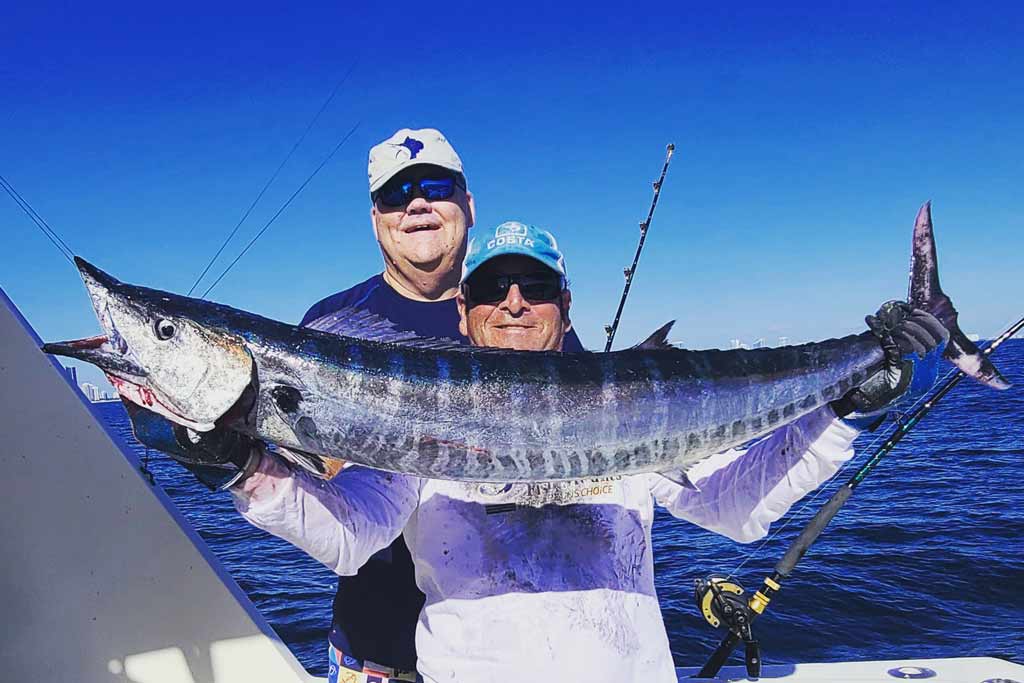
When?
The Wahoo season in Florida depends on your location. You’ll find these aerodynamic beasties on the Atlantic Coast all year. Wahoo are particularly fond of Southern Florida’s warm waters. Winter can be very good for Wahoo fishing in Florida because they come closer to land and feed around reefs. In summer, you can catch them all over the state, but you’re in for a bit of a boat ride before you get to them.
Where?
Wahoo aren’t schooling fish, so they mostly hit it off on their own or in small groups. They prefer to hunt in waters up to 500 feet deep, sometimes even more. However, Wahoo are pelagics, so they look for food close to the surface, though they’re not uncommon around deepwater reefs, too. You’ll need to travel 20–50 miles offshore to find them, which can be quite a boat ride. The best destinations to target Wahoo are Miami, Stuart, Jacksonville, St. Augustine, and the Keys.
How?
Toothy Wahoo love to eat, so they’re not very demanding about what they devour. High-speed trolling is the most productive way to get them to bite. For a more hands-on approach, you can give vertical jigging a try, or even spearfishing if you’re feeling adventurous. Sardines, mullet, ballyhoo, and pilchards used as live bait won’t disappoint. Lures that give good results include diving plugs and wahoo jigs.
Groupers
Groupers are stars of the bottom fishing scene. They come in 17 different varieties, which makes them interesting prey for all levels of anglers. Black, Gag, Red, Goliath, Snowy, and Scamp Groupers are the most common subspecies you could reel in. These know how to fight and use their weight to their advantage, so they’re no joke to land. The main reason everyone wants them is that they’re pure deliciousness on a plate. Bear in mind that each of the subspecies has its own seasonality and regulations, so make sure to check those before you head out.
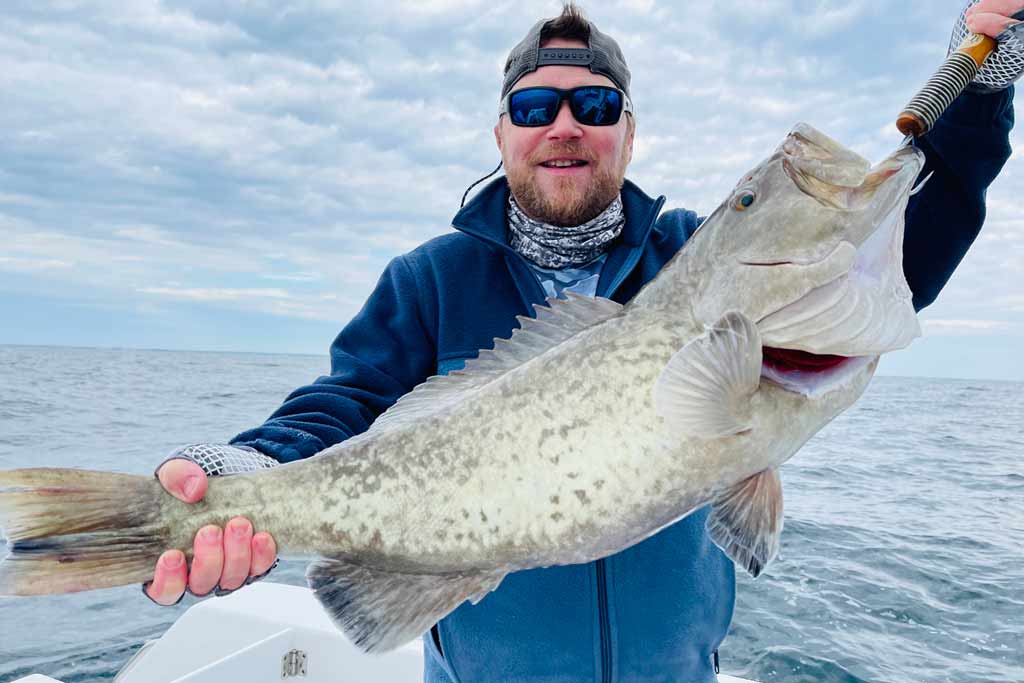
When?
Because there are so many different subspecies, there isn’t any one time of the year that’s best for targeting them all. Some of them have closed seasons, so it’s good to talk to your captain before you start fishing. Broadly speaking, summer and late fall is the best time to get on a Grouper bite.
Where?
Rocky bottoms, reef edges, drop-offs, and structures on the seafloor are the home of most Groupers. You can find a Grouper anywhere in Florida, but the varieties differ. Fort Lauderdale, Marathon, Pensacola, Key Biscayne, and Miami are all on the to-fish list.
How?
Charter captains employ different techniques to get Grouper to bite. Whether it’s bottom fishing, trolling, or deep dropping for trophy catches, heavy-duty tackle is a must. Since you’ll be fishing waters that can be anywhere from 100–1,200 feet deep, you’ll need a sinker to hold your offering at the bottom. Speaking of which, live bait works best on Groupers, specifically mullet, pinfish, or pilchards.
Snappers
Among Florida game fish, Snappers take a very special place. There are 15 subspecies at your disposal, and they live in different habitats. You can fish for Mangrove, Yellowtail, and Lane Snapper with your family, then head further out to target the legendary Red Snapper, along with their Vermilion, Mutton, and Cubera relatives. Depending on the subspecies, these fish can weigh from 2–50 pounds.
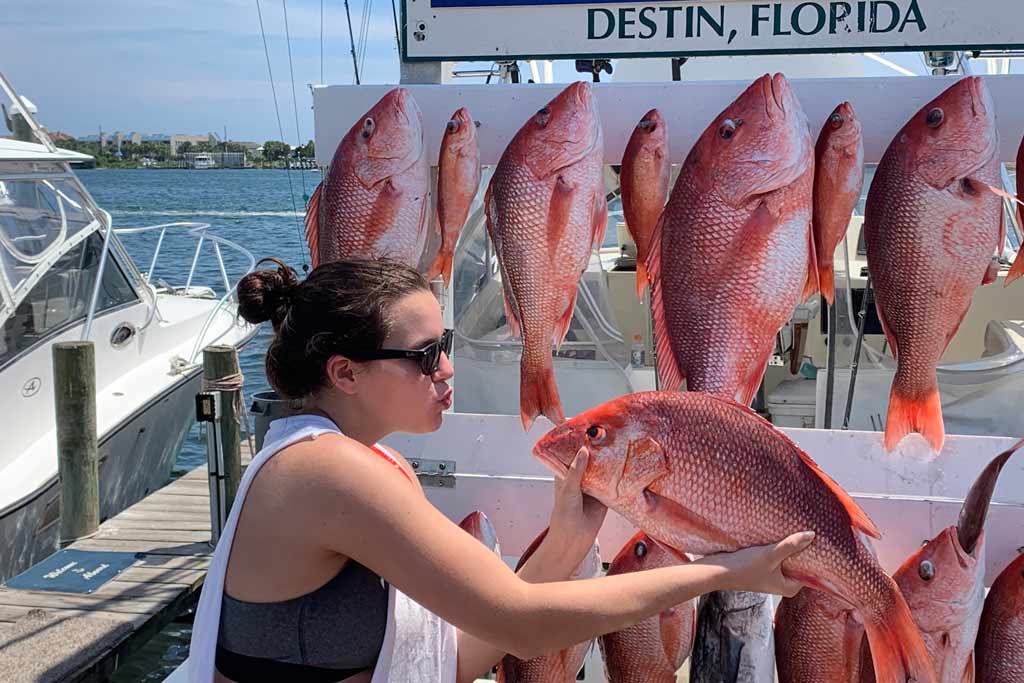
When?
Whenever you hit the waters of Florida, chances are at least one of the Snapper species will be in season. Some of them are open for fishing year-round, while others, especially Red Snapper, have strictly regulated seasons. Reds can be fished for only a couple of months in the summer. This can also be a good time to go out and catch just about any Snapper you’d like.
Where?
Snappers live in every part of the water column, but one thing they’ve got in common is structure. They’re ambush predators and need cover to get their food. You’ll find them inshore, around big rocks, bridges, artificial reefs, and sunken wood. Nearshore and offshore, natural and artificial reefs, as well as wrecks, are their gathering places. When it comes to top Snapper destinations, the entire Florida Panhandle is your playground, with Destin and Pensacola at the top of the list.
How?
The foolproof way to get a Snapper to bite is to entice them with their favorite bait fish like pinfish and cigar minnows. They won’t refuse the offering of squid, octopus, shrimp, or bonito strips either. Live and cut bait is generally more productive than lures. But you can give artificials a try with jerkbaits, spoons, and soft plastics. Light tackle is a good choice for inshore fishing but, for deeper waters, you need strong tackle, egg sinkers, and a wire leader.
Amberjack
Passionate bottom fishermen swear by the brute strength of an Amberjack strike. These brawny fish didn’t get the nickname “reef donkey” for nothing. Their strikes and first runs are forceful, and they’ll fight you for every inch of the line. Their average weight is up to 40 pounds, but there are trophy-sized fish that go well into the triple digits. Even though there are several subspecies of AJ, Greater Amberjack is the most common catch in Florida.
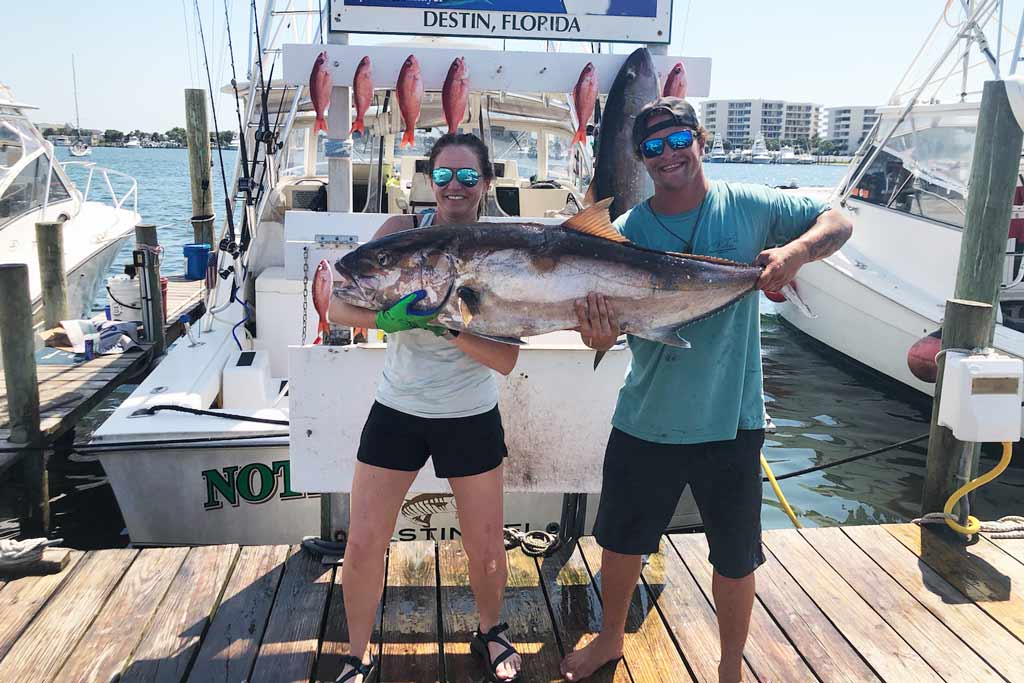
When?
Like so many Florida game fish, Amberjack stick around and feed throughout the year, though the warmest months are usually best for fishing. That’s why late spring and summer are the time to go out if you’re on the lookout for a new personal AJ record.
Where?
Depths between 200–300 feet are the sweet spot for Amberjack to live and thrive. They like their deep reefs, wrecks, and oil rigs because they’re opportunistic feeders and prefer an easy bite. Panama City Beach, Key West, Destin, Marathon, and Palm Beach are all good starting points for your AJ hunt.
How?
Amberjack are fighters like no other bottom fish, so you’ll need strength and patience to win the battle. The easier part is to get them to take the bait, because they don’t mind eating anything, as long as they don’t have to work for it. These fish have a mean temper, so you need extra strong hooks and even stronger lines. AJ love their squid and octopus, so that’s the best choice for live bait. On the artificial side of things, you can try your luck with jigs and spoons.
Tuna
Our talk about top Florida game fish wouldn’t be complete without Tuna. There are 8 different types of Tuna you can target, but Blackfin and Yellowfin Tuna are by far the most popular. Blackfins are numerous and combative to the end. They’re on the smaller side, usually weighing between 15–30 pounds. Yellowfin Tuna live farther away, can weigh triple digits, and fighting them is like pitting yourself against a freight train! A Tuna hunt is an experience like no other, which is why it’s a favorite of many saltwater fishermen.
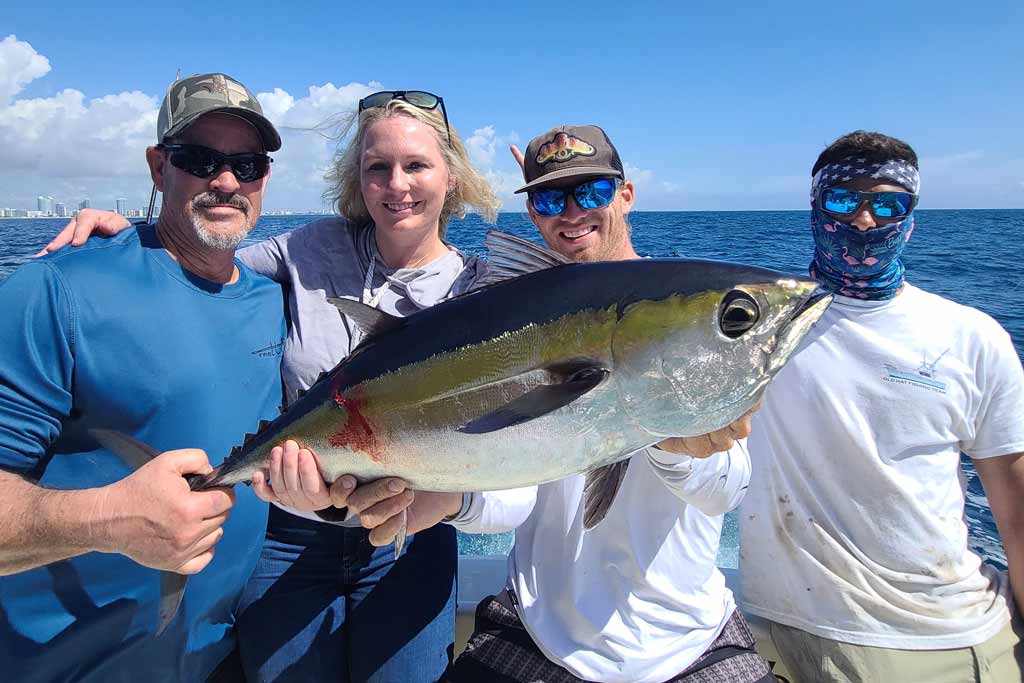
When?
The best time to go after Tuna is in spring and summer because this is when they start their migration. Both Blackfin and Yellowfin are at their best and hungriest during April and May, though Blackfin stick around during the winter as well.
Where?
You can find Tuna both on the Atlantic Coast and in the Gulf. The main difference is that Blackfin are closer to land on the Atlantic side. If you’d like to chase after Yellowfin, you need to be prepared for long trips to into the Gulf’s deepwater. Tuna like to feed around structure, so deepwater reefs, humps, and wrecks are their frequent haunts. For the best chance of landing elusive Tuna, head to Marathon, Miami, Cocoa Beach, Key West, and Destin.
How?
The torpedo shape of Tuna tells you a lot about their movement – they’re fast and powerful! Once hooked, they run deep for cover, so ’em them in requires a lot of patience and strength. To attract Tuna, chumming with live bait is a tried-and-true method. Trolling, kite fishing and vertical jigging all give good results. Blackfins are mean machines on light tackle, but for more robust Yellowfins, you’ll need equipment to match. Don’t forget a fluorocarbon line, because Tuna have amazing eyesight and you don’t want them to see your line and flee.
Sailfish
We’re officially in the Billfish domain, where game fishing gets to a whole new dimension. And out of all Billfish, Atlantic Sailfish is the most coveted catch in the Sunshine State. These underwater gladiators weigh up to 100 pounds and are fierce opponents for even the most skilled anglers. Aerial displays, tail-walking, and headshakes make it very hard to land a Sailfish, so naturally, a lot of people want to test their mettle against them.
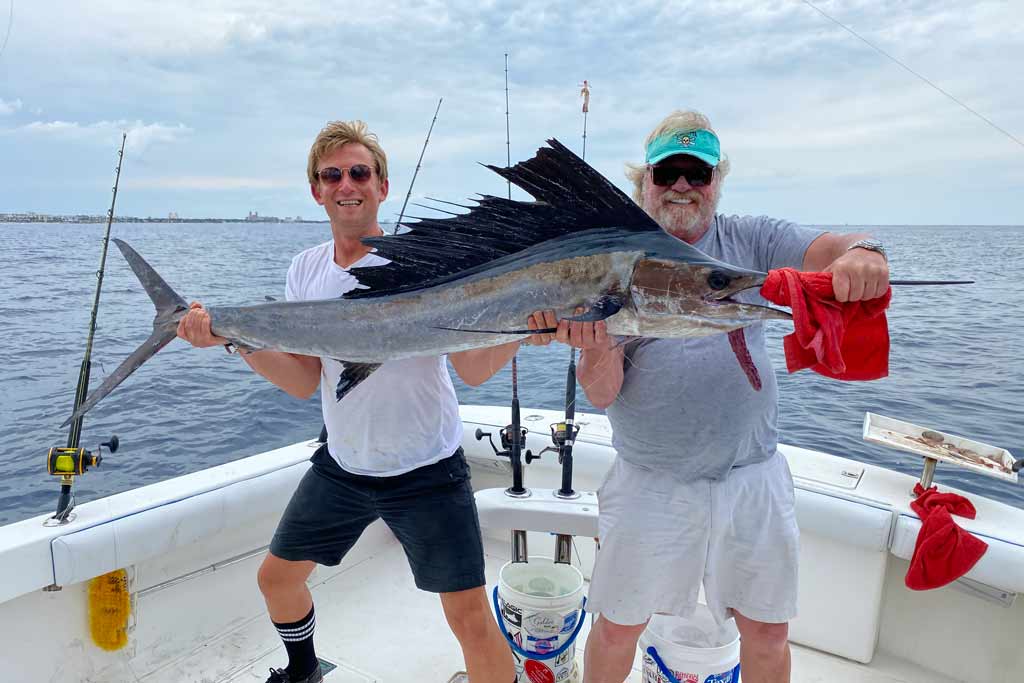
When?
Unlike most Florida game fish we talked about, the high season for Sailfish action is during winter. The period between November–March is by far the best time of the year to knab a Sail. You can get them in the Gulf as well, but you’ll need to travel to deep waters in the summer months.
Where?
One sure way to locate Sailfish is to follow the Gulf Stream, just like they do. In the winter, the stream is close to Florida’s Treasure Coast, and you can hook into a Sailfish only a few miles from land. Here, you’ll find the famous “Sailfish Alley” that stretches for 60 miles. Stuart is the epicenter of Sailfishing action, along with Islamorada, West Palm Beach, Jupiter, and Miami. If you’re looking for Sailfish on the west coast, you’ll need to travel 40+ miles offshore.
How?
Since Sailfish are a pelagic species, and also happen to be the fastest fish in the sea, trolling is the safest way to get a bite. Kite fishing has become more popular in the previous years, as well as fly fishing. But Sails can’t resist live bait, be it ballyhoo, mullet, or blue runners. Dead and cut bait like Bonito and Mackerel strips are a close second. If artificial lures are your jam, spoons, hard plastics, and even feathers are the way to go.
Marlin
If there is a pinnacle of sportfishing, the crowning achievement on every angler’s bucket list must be landing a Marlin. There are two types you can target in Florida – Blue and White Marlin. Whites are the smallest in the Marlin family and usually stay in the 90–150 lb ballpark. They’ll fight you furiously, but due to their more manageable size, they’re suitable for less experienced Billfish anglers. Blues are true monster catches, with their weight going from 500 to well over 1,000 pounds. To reel them in, you need stamina, experience, and strength.

When?
Marlin like warm waters, so it’s not surprising that the best time to target them is in the heat of the summer. They also stick around in the first half of the fall, when the crowds on the water aren’t as bad.
Where?
Both the Atlantic and the Gulf of Mexico are Marlins’ playgrounds. Similar to Sailfish, they follow the Gulf Stream religiously, and they feed around deep ledges and drop-offs. That’s why one of the best places to go Marlin fishing is Destin – this is where the 100-fathom curve is, and where your prey congregates. Then you’ve got Key West, Key Largo, St. Augustine, and Panama City Beach.
How?
The safest way to entice a Marlin to bite is trolling. Use either loud and splashy lures or their favorite fish as cut bait to get their attention. Trolling lures come in all shapes and sizes, and they should be picked depending on the shape of their head and movement on the water. For live or dead bait, ballyhoo is always a good option, as well as strips of Skipjack Tuna and Bonito.
Swordfish
Swordfish might be the last on our list of favorite Florida game fish, but it’s certainly not the least. On the contrary! They’re the hardest Billfish to find, their fighting abilities are unmatched, and they do not go down easily. They can grow to be huge – from 200–1,200 pounds. But what sets them apart from the other Billfish is that they spend their days feeding near the bottom at the depths of over 1,000 feet. Getting them to the surface is a mammoth task, but what glory it brings.
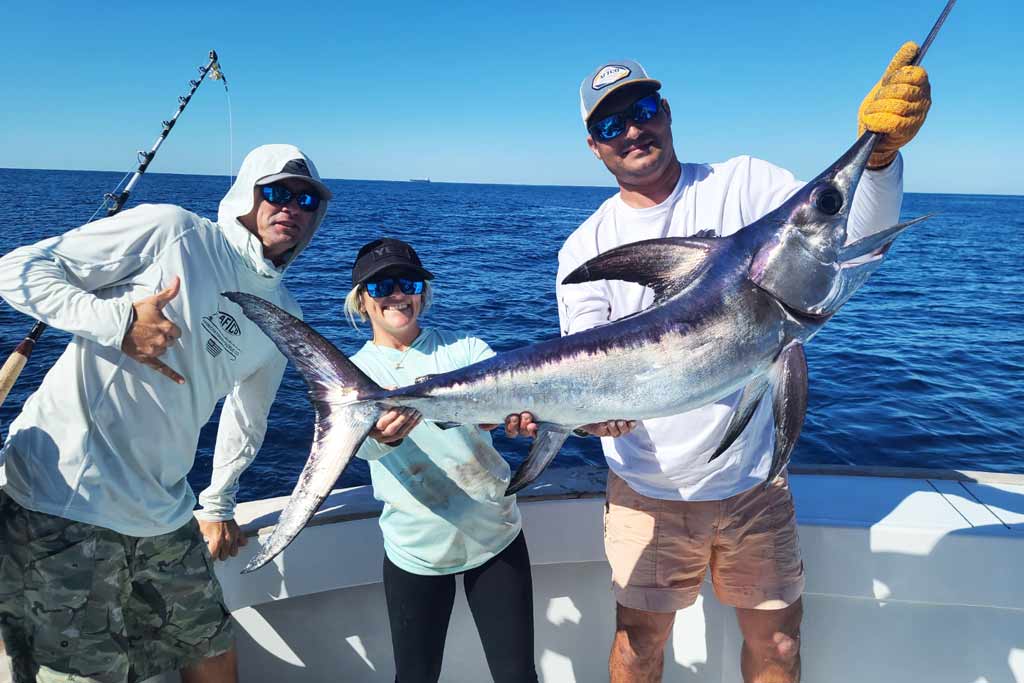
When?
Swordfish like the temperature of Florida’s waters, so they stick around the whole year. For the best chance of a legendary bite, get out into the bluewater in summer and early fall (June–October).
Where?
The vast majority of Swordfishing is reserved for the Atlantic Coast, especially the southern part of it. This is where Swordfish come to spawn and where they spend most of their life. You’ll need to travel at least 20 miles to get to their feeding grounds, so be prepared for a boat ride. Not to much surprise, the best Swordfish fishing locales are Miami Beach, Fort Lauderdale, Jupiter, Pompano Beach, and of course, Key West.
How?
Night fishing for Swordfish is the go-to method for getting this mighty species on the line. This is when they come closer to the surface, and when anglers can tempt them with live bait like goggle eyes, mullet, and blue runners. If you’re after giants, you should use smaller Tuna species and Mackerel. There’s usually a battery light or a glowstick to get Swordfish’s attention in the dark. Daytime Swordfishing has become popular lately, but it requires special equipment and a lot of time to get the fish to the surface.
Florida Game Fish: Countless Glorious Catches Await
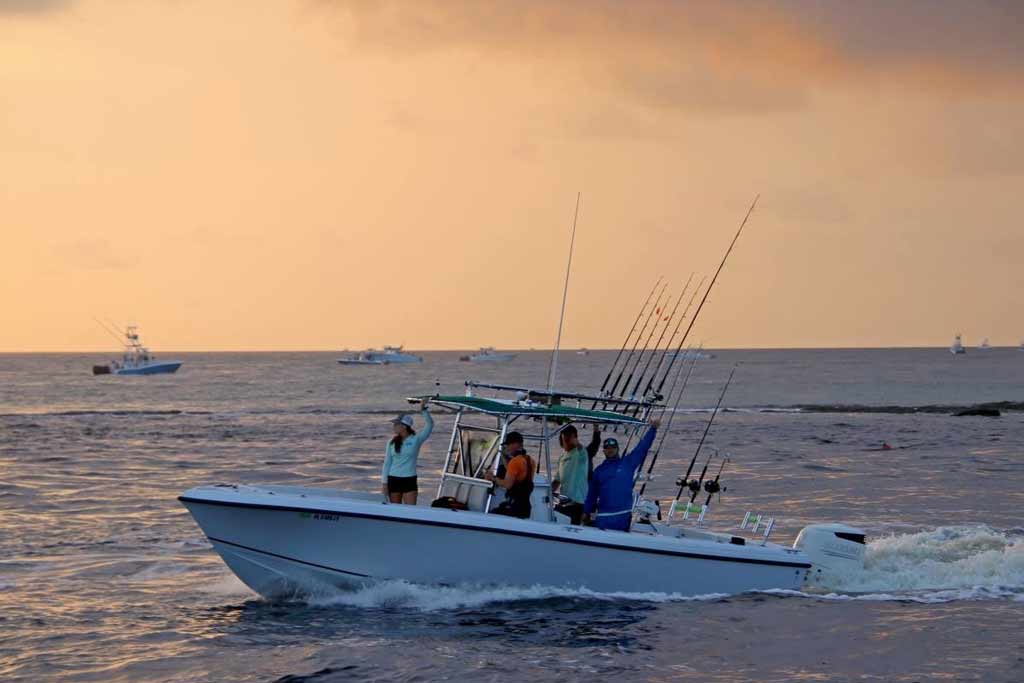
We know this is a big list, but this is just the beginning! The topic of game fish in Florida deserves its own encyclopedia, and we only covered the best of the best in this article. Now all you need to decide is what you’re going to catch and have your rods at the ready!
Do you have a favorite game fish in Florida? Did we miss a species that deserves to be on the list? Anything else you’d like to add? Share your stories in the comments.
The post Florida Game Fish: The Sunshine State’s Top Targets appeared first on FishingBooker Blog.
https://ift.tt/IxKDYvL
0 Comments
Enregistrer un commentaire